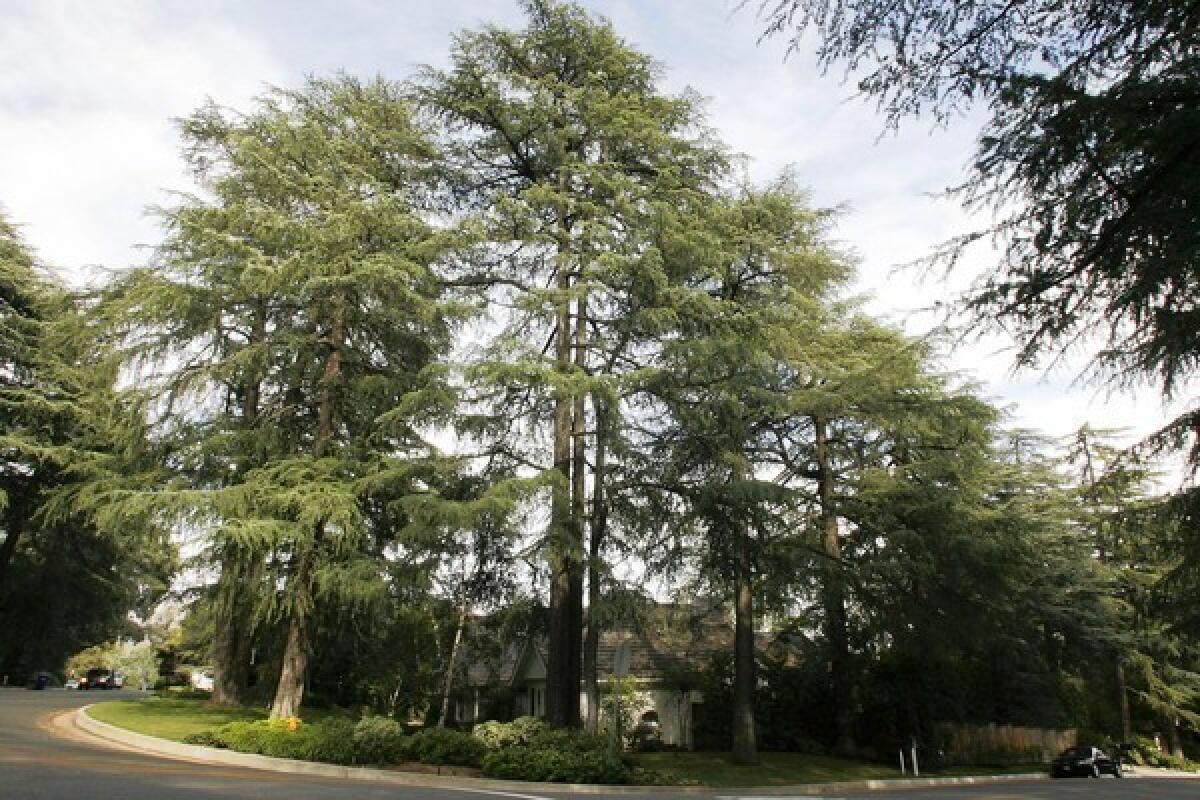La Cañada Flintridge to preserve deodar cedar’s history

On a walk through the upper Alta Canyada neighborhood of La Cañada Flintridge, people and large estates appear dwarfed by rows of deodar cedars.
The towering trees, which are more than 100 feet tall in some areas, have become an icon of the neighborhood and residents don’t want them harmed. When the City Council prepared to approve a tree ordinance in March that would protect the California sycamore and a variety of oaks but omit the deodar cedar, residents protested.
Council members have proposed a compromise: a historic deodar district that would protect the tree where it defines the character of the neighborhood.
The Cedrus deodara grows in the Himalayas and is not native to California, despite its storied legacy in La Cañada Flintridge and in other neighborhoods in the Los Angeles area.
The tree first came to La Cañada in 1913, after Edwin T. Earl bought 500 acres of land there in 1910. He was said to have brought the young deodars in 5-gallon cans. Earl also named the region, adding the “y” to Alta Canyada as a nod to the pronunciation of the Spanish name. He intended to turn the area into a suburban park.
“The trees must have been five to 10 years old when they were planted,” resident Robert Lyans told the Los Angeles Times in 1956, adding that the saplings probably cost Earl $3 to 5 apiece.
The La Cañada deodars were planted after Altadena founders John and Frederick Woodbury created their own deodar-lined neighborhood. In 1885 they planted the trees that later became the centerpieces for Christmas Tree Lane.
But it is uncertain if Earl was inspired by the Woodbury brothers or simply encouraged by the tree’s ability to grow quickly, said Tim Gregory, an archivist at the Lanterman House, La Cañada’s historical museum.
The trees were never covered in lights or attracted visitors like those in Altadena, but came to define quiet, scenic hillside streets that also offered residents shade and privacy.
Robert Craven, who lives on Linda Vista Drive, said some residents dislike the shade offered by the deodars because they believe it makes the neighborhood “gloomy,” but the majority of La Cañadans enjoy living in a woodsy enclave.
“I think many people are attracted to the [Alta Canyada] neighborhood because of the big trees,” he said. “We have redwoods and a number of big pine trees. This is a neighborhood where the trees are very important to the people who live here.”
If approved, the new ordinance would protect the deodars only in certain areas of the city. The law would also punish residents or arborists who damaged a deodar or other protected trees. The city is currently determining the fees for violating the ordinance and replacing the tree.
Craven, who helped the city’s planning department craft the law, said it is intended to shield the area from new arrivals who may not know about the tree’s history or from developers who want to cut the trees down.
Deodar cedars with a trunk diameter of 12 inches or greater would be protected along a section of Alta Canyada Road that is north of Alta Park Lane and Palm Drive north of Fairmont Avenue. The deodar would also have permanence on Bonita Vista Drive, Bubbling Well Lane, Del Oro Drive, Earl Drive, Earlmont Avenue, El Vago Street west of Indian Drive, Fairmount Avenue, Hacienda Drive, Hillard Avenue, Jarvis Avenue, Linda Vista Drive and Louis Drive.
Craven, 80, has lived in La Cañada Flintridge since 1968. From a window in his home, he can see a deodar with a sizable trunk standing in a neighbor’s yard.
“It’s an absolute beauty,” he said. “I would definitely miss it if it were ever gone.”
--
Follow Tiffany Kelly on Google+ and on Twitter: @LATiffanyKelly.